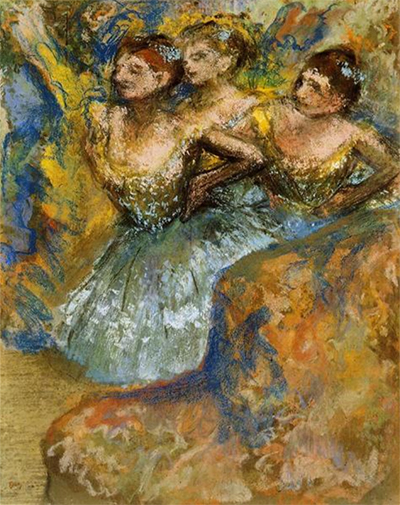An array of colour is a classic characteristic of the famous 19th century French artist, Edgar Degas. While the artist has been noted as one of the founders of impressionist art, Degas preferred to be seen as a realist artist upon which he founded his work.
The artwork, Group of Dancers, is one of the first pieces by Edgar Degas, dating back to the 1900-1910s. The piece is based on an impressionist style that interconnects an array of colour and movement together as one. The medium Degas uses to illustrates these female figures is pastel on paper. The artist is most famously known for illustrating brilliant oil on canvas pieces that depict the movement of dance and form as seen within his work, Group of Dancers. The artist's rendition of dance is a trademark characteristic within his work, a similar style to his contemporary Claude Monet.
The captivating artwork explains Degas's desire to showcase the frailty of the female form in a natural rhythm and style. These three provoking women stand together as their gaze is all caught towards the same direction. These women gently lean upon each other as they try to catch a glimpse of something in the distance. These figures are dressed in ballerina attire that glows outwards in a great poof. Their hands are gently placed upon their waist as they push their chest outwards. Degas uses a bright colour scheme to showcase the artwork. From shades of yellows, to blues standing as the focal colours of the piece. The blue and yellow shades fill the outline of the ballerinas as they stand near one another. The impressionist style holds the foundation of the piece as shades intertwine into one another as one melody. Degas depicts the skin of the woman in a light nude pastel colour, contoured by a darker nude to show the depth of their features.
Both the woman at the front, and the woman at the back are illustrated with deep brown hair, whereas the figure within the middle holds light blonde hair. Degas uses a light rosy colour to accentuate the features of the woman at the back, as their cheeks hold a hint of pink, flowing onto the chest. This touch gently accentuates the woman in comparison to primary ballerina that catches the viewer's attention. The deep pastel colours swerve together showcasing a classic impressionist style. Since the artwork is dated as one of the first pieces by Degas, the founding technique is evident. Degas melts the three women into the background of the artwork through swirls of colour filling the screen. The technique behind the pastel material seems to resemble a dabbing technique used to smudge the colour.
Degas had first illustrated the background of the artwork before painting the three figures in the middle. This allows for the artist to create a background prior to bringing attention towards the three women. Degas had used a soft dab of light blue against the skirt of the ballerina's attire in order to illustrate its flowing form. Similarly, each woman’s bust is highlighted with a yellow pastel, showcasing a contrast between the yellow and baby blue. Degas is known as a master of colouring, understanding the ways in which these shades complement one another. The artist also carries a significant understanding of emotions that evolve through different shades within the work. The multi-coloured pastel masterpiece eludes a positive feel as it is swarmed with an array of bright shades. It is evident as to why Degas is viewed as one of the founding artists of Impressionism, as his flowing palette of colour dominates his artwork.




